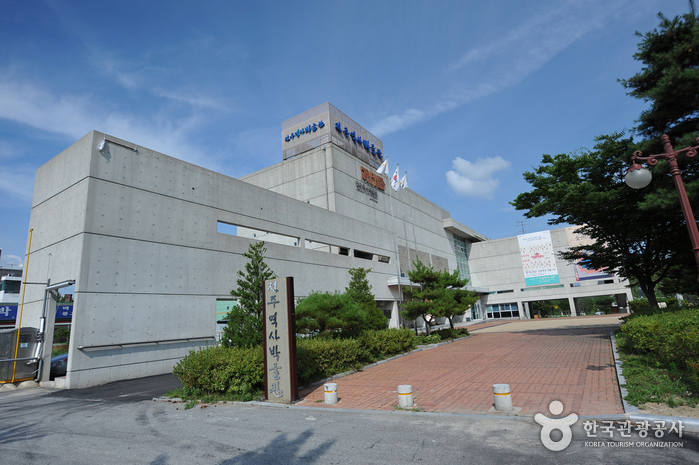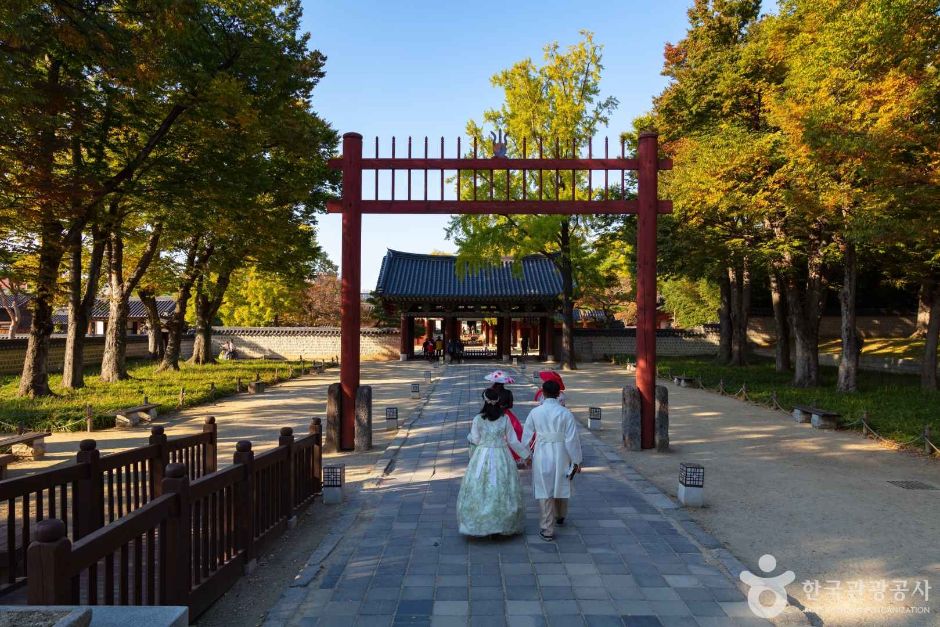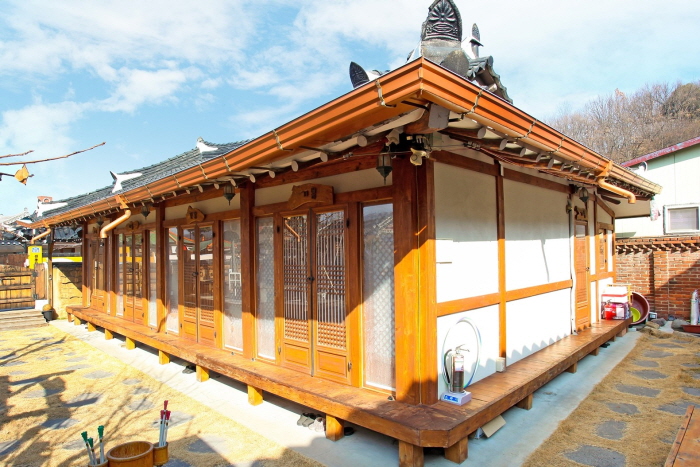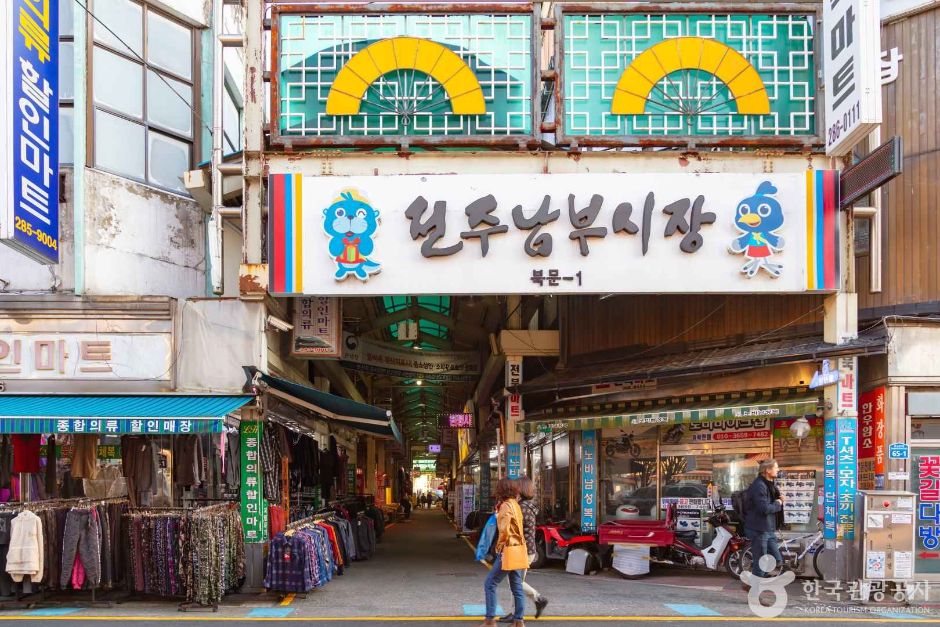Instituto Jeil de Jeonju (전주 제일고등학교)
6.7Km 2024-10-22
Namnosong-dong 180-1, Wansan-gu, Jeonju-si, Jeonbuk-do
Aldea Tradicional de Jeonju (Cittaslow) (전북 전주 한옥마을 [슬로시티])
6.7Km 2025-07-09
Girin-daero 99, Wansan-gu, Jeonju-si, Jeonbuk-do.
La Aldea Tradicional de Jeonju (Hanok Maeul) está ubicada en las zonas de Pungnam-dong y Gyo-dong. En esta área se encuentran concentradas aproximadamente 800 casas tradicionales de Corea, las hanok. Este lugar es famoso por conservar intacto el estilo tradicional, proporcionando la oportunidad de disfrutar el ambiente antiguo y folclórico del país.
Lo más elegante de esta aldea es seguramente el estilo de los techos de las hanok. La peculiaridad de esta vivienda es que el borde de los techos está ligeramente dirigido hacia el cielo. La estructura de estas casas se divide en dos secciones: anchae y sarangchae. Anchae, siendo el lugar donde permanecen las mujeres, también es llamado gyusubang; mientras que el sarangchae es el lugar utilizado por los hombres, también llamado seonbibang. La construcción arquitectónica diferencia el sector destinado a los hombres y mujeres. De tal manera, el anchae, por ser el lugar donde residen las mujeres, se localiza en la parte más resguardada y silenciosa de la casa.
Otra característica es que los cuartos son de ondol, un sistema de calefacción instalado en el suelo. La estructura del ondol es bastante simple, consiste en aplicar el sistema de calefacción debajo del piso, con pasajes horizontales para el humo y una chimenea vertical para el escape. Una de las grandes ventajas es que en verano es fresco y en invierno, caliente.
Además de los recorridos, observando la sabiduría y las costumbres tradicionales de la antigüedad, otro de los atractivos lo componen las actividades culturales que consisten en experimentar las habitaciones de ondol y degustar del plato típico famoso de la ciudad, el bibimbap (arroz mezclado con surtido de vegetales).
Museo de Historia de Jeonju (전주역사박물관)
6.7Km 2024-04-07
Ssukgogae-ro 259, Wansan-gu, Jeonju-si, Jeonbuk-do.
El Museo de Historia de Jeonju se fundó en el año 2002 para hacer llegar al público la larga y fascinante historia de Corea. Este museo está dividido en diferentes áreas de exposiciones y está abierto permanentemente.
La primera exposición es la de la Revolución Agraria Donghak (levantamiento del año 1894 contra los intentos de colonización japonesa). Este suceso cumplió un papel muy importante en el desarrollo de la ciudad de Jeonju. La segunda área de exposición está dedicada a las milicias movilizadas. También hay un área especial dedicada al Movimiento por la Independencia contra el imperio japonés. Hay muchas otras exposiciones con los temas claves y sucesos importantes de la historia de Corea.
Santuario Gyeonggijeon (경기전)
6.7Km 2025-07-09
Taejo-44, Wansan-gu, Jeonju-si, Jeonbuk-do.
El Santuario Gyeonggijeon fue fundado en 1410 y es donde se guarda el retrato del rey Lee Taejo, el fundador de la dinastía de Joseon, dibujado en Jeonju, Gyeongju y Pyongyang. La estructura fue parcialmente destruida durante la Guerra de Imjin de 1592 a 1598. La estructura actual fue reconstruida en 1614.
Museo Nacional de Jeonju (국립전주박물관)
6.7Km 2024-10-15
Ssukgogae-ro 249, Wansan-gu, Jeonju-si, Jeonbuk-do.
Fue inaugurado en el año 1990 y es un organismo perteneciente al Ministerio de Cultura, Deporte y Turismo. Colecciona y preserva los patrimonios culturales de Jeonbuk-do, y se dedica a las actividades académicas de investigación y exposición. Se esfuerza activamente para ser el centro de la cultura regional en los intercambios nacionales e internacionales. En noviembre del 2002 se abrió al público la sala de educación social, que es un espacio destinado a las actividades culturales participativas, permitiendo así la oportunidad de experimentar la cultura tradicional. El museo posee aproximadamente 30.000 reliquias del pasado, entre ellas se encuentran piezas encontradas en la región de Jeonbuk-do, pinturas budistas, vasijas de porcelana, artesanías en metal, pinturas y caligrafías, libros clásicos, etc., entre otros. Unas 1.300 piezas se encuentran expuestas permanentemente en 5 salas interiores y exteriores del museo. También tiene varias exhibiciones especiales relacionadas a la cultura regional de Jeonbuk-do. Además presenta varios eventos culturales y programas educativos, para que los visitantes puedan experimentar la historia en el museo.
Gaeunchae (가은채)
6.8Km 2025-07-18
68-13, Hanji-gil, Wansan-gu, Jeonju-si, Jeonbuk-do
Gaeunchae is a hanok stay in Jeonju Hanok Village, Jeonbuk-do, constructed of wood in the traditional way without using nails. The location is ideal for local sightseeing as it’s close to Jeonju Craft Masters Hall, the Traditional Wine Museum, Seunggwangjae (home of the last Joseon prince Yi Seok), and Dakjong Hanji Doll Workshop. The exceptionally scenic alleyways around Gaeunchae are part of a Village tour. In the yard visitors will see different types of stone used as paving or decoration: granite, mica, and other local stones, all hand-trimmed by our ancestors.
Puerta Pungnammun de Jeonju (전주 풍남문)
6.8Km 2024-04-07
Pungnammun 3-gil 1, Wansan-gu, Jeonju-si, Jeonbuk-do.
La puerta Pungnammun se ubica donde estaba la puerta sur de la antigua Fortaleza de Jeonju. Sus primeras construcciones datan de los años 1734 y 1768, y tras ser parcialmente desmantelada por tareas de planificación urbana, finalmente recuperó su forma original en 1978.
Museo de Licor Tradicional de Jeonju (전주 전통술박물관)
6.8Km 2024-05-07
Hanji-gil 74, Wansan-gu, Jeonju-si, Jeonbuk-do.
El museo desea recuperar los métodos tradicionales de producción del licor que se adecúe al estilo actual. Para cumplir esta meta, establece clases llevadas a cabo por maestros quienes revelan sus secretos de elaboración del licor, y, de esta manera, los visitantes podrán preparar su propio licor casero. También trata de difundir la cultura tradicional de tomar el licor, elegantemente, como la costumbre que tenían los antepasados. En particular, el museo también se esfuerza para promocionar y propagar el licor tradicional de Corea, de tal manera que establece eventos y festivales periódicamente. Además, los turistas extranjeros que visiten la ciudad de Jeonju tendrán la oportunidad de degustar el licor en este museo.
Siwon (시원)
6.8Km 2025-07-18
45-41, Omokdae-gil, Wansan-gu, Jeonju-si, Jeonbuk-do
Siwon is a timber and clay-built hanok stay, part of Jeonju Hanok Village in Jeonbuk-do. It has four guestrooms, all but one with a small attic - so guests can have fun climbing up and down the ladder! The rooms have all been insulated and draft-proofed to keep visitors warm and comfortable. In the yard is a small garden and swing, and guests can play traditional games such as Tuho and Jegichagi - or even take part in a carpentry workshop. Must-see sites such as Gyeonggijeon, Jeondong Cathedral, Omokdae, and Nambu Market can all be reached on foot.
Mercado Nambu de Jeonju (전주 남부시장)
6.8Km 2025-07-09
Pungnammun 1-gil 19-3, Wansan-gu, Jeonju-si, Jeonbuk-do
Establecido en 1905, el Mercado Nambu de Jeonju es hasta la actualidad un importante punto de comercio, de economía y de transporte para los habitantes de la ciudad de Jeonju. Desde finales de los 60 hasta los años 70, el precio del arroz en general se determinaba en este mercado, mostrando así su gran influencia en los mercados de Corea. Actualmente, unas 800 tiendas se encuentran en el predio. Todos los viernes y sábados hay un mercado nocturno donde se pueden probar platos para picar como morcillas, tortitas y rollitos.

![Aldea Tradicional de Jeonju (Cittaslow) (전북 전주 한옥마을 [슬로시티])](http://tong.visitkorea.or.kr/cms/resource/50/3479250_image2_1.jpg)






 Español
Español
 한국어
한국어 English
English 日本語
日本語 中文(简体)
中文(简体) Deutsch
Deutsch Français
Français Русский
Русский